|
0 Comments
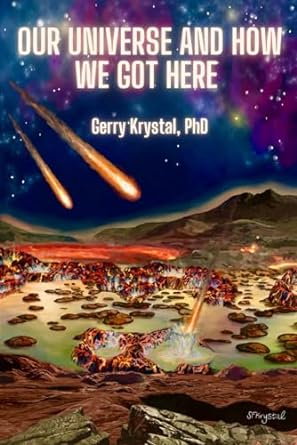 This book addresses the biggest questions we can ask, or at least many of them. It covers a lot of ground. The author is a biochemist (and a local), and as you might imagine, the book address physics, astronomy, the history of Earth, etc. and biology, with the emphasis on biology. It lacks an index which is a real shame. The biology sections of the book introduces many scientific words with non-obvious definitions. I am not a biologist, and an index would have helped me get through them. The author is aware of this and does his best to explain complex chains of actions in simple terms. He writes in a very folksy style, likes Douglas Adams, and cracks the odd pun or four. There is little point in summarizing a book that is summarizing literally everything. Life started about 4 billion years ago(bya). Then came LUCA, the Last Universal Common Ancestor at about 3.5 bya. The first categories of life were Archaea, Eukaryotes (cells with a nucleus), and Bacteria (cells without a nucleus). We are eukaryotes. Over the eons, the Earth has been molten, and then frozen, and then hot again; has had no oxygen to having an atmosphere loaded with it; gone from low CO2 to high CO2 and back, and so on. Sex was invented and evolution took off. There have been several mass extinctions in history, The Permian was the largest, and the asteroid that killed the dinosaurs 65 mya was the last. I finished this book, but did struggle with biology sections…. Largely because biology is really complex. Worth reading, especially if you have a little biology in your back pocket. 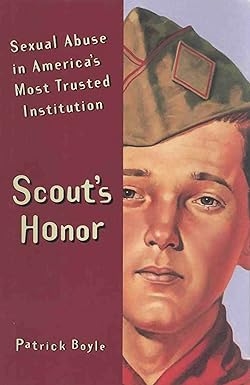 This book is old news. The BSA (Boy Scout's of America) has been on the ropes for sometime. I have read and written about The Roman Catholic Church ands its decades long struggle with priest's raping boys. By "struggle" I mean its ongoing efforts to bury the story, keep its money, and protect the perpetrators. But a priest only get s unsupervised access to boys for perhaps half a day, whereas a scout leader gets them for entire weekends. The BSA makes the RCC look like novices. The book is written chronologically, each chapter moving ahead by a month or a year. Intertwined with that account is the story of Carl Bittenbender, a serial abuser, and Cindy Corbett, the mother of one of Carl's victims. Carl was court martialed out of the military but had no trouble getting a gig as Scout Master. He was charged with molestation, and still had no trouble getting another Scout Master job. No one checked. They thought this sort of thing happens to other communities. They thought that the BSA kept records, so they would catch pedophiles. The BSA did keep records, but they were "confidential" and using them could create law trouble. The parents were happy to have the kids out of the house. But BSA leaders wanted none of it. Checking people out costs money. They did keep files, but they would never look at them. Why? Because then they might actually know the answer to questions like "How many records of sexual abuse does the BSA get per year?" One person said "I do not know how many we get per year, but it is miniscule." Think about that answer. It is self contradictory. Pedos are smart. They can spot a possible target, perhaps a troubled looking kid, or a loner, with a quick glance around a room full of boys. They are persuasive. They work their victims slowly. They can use pot and beer to gain control ("We would not want your parents to know about this, so say nothing!"). There was always a reason why it was not the BSA's fault, or that the BSA could not afford to do this or that. When the BSA would estimate x number of assaults per year, they real number was en times that. Other organizations like Big Brothers knew better and ran criminal checks on all their adults. In one case, a monk (Brother Edmund) abused a boy who ultimately killed himself. Law suits followed, and two years later, he was banned by the BSA. By 1982, a Scout Leader was being banned every eleven days. The BSA issued a warning to its boys about mutual masturbation, saying it as wrong. They offered no such warning if an adult was involved. One abuser was kicked out, only to let back in when a psychologist said he was cured. He re-abused. If this book contains one message, it is that abusers cannot be cured. They need regular treatment for life. I have a lot of disdain for clinical psychology in the 80s and 90ss, but I am given to understand that the science behind it has improved a great deal since. Carl, after years of abusing boys, was finally jailed for 30 years. He got out after 20, and died a few years later. By the end of the eighties, the BSA was under attack. Law suits and outrage were the harvest from years of deliberate ignorance and general all-round lying. 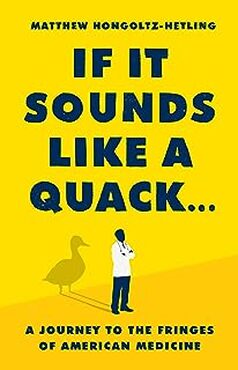 I really enjoyed this book. It is a good look at the sleazy underbelly of the snake-oil "One True Cure". And it is funny. The author has a first class sense of humor, which is rare in serious journalism. The book has an extensive bibliography. But no index! That is weird. Computers make creating an index very easy. It is a bit of work to do it right, but it is worth it for the reader. The narrative takes a different course than most books. Instead of telling a series of stories about seven One True Cure (OTC) promoters, the books chops each quack's tales into four pieces… roughly speaking: Getting started, the early years, the latter years, and the end. This allows you to compare each whacko's experiences with the others over time. The down side is that is it hard to keep up with narratives like that. You lose the thread of one nut-bar and then have to pick it up again three more times. The main players and their One True Cures are: Larry Lytle; A laser pistol OTC Toby McAdam: Herbal Supplement OTC Robert O. Young: Bleach OTC Alicia Kolyszko: Leeches OTC Dale and Leilani Neumann: Prayer OTC An Alien inside a human skin: MMS (Miracle Mineral Solution) OTC Mara-A-Lardo is mentioned many times, but only by the moniker "former game show host". As I mentioned, I find humor injected into the serious work of journalists who are trying to get to the truth is a necessity when the truth is that these people are nuts, evil and/or self-deluded. Twenty-five years ago (or so) I a wrote a piece on the difference between pseudo-science and proto-science. The I issues I raised in that piece, not surprisingly, cropped up constantly in this book. Many people needlessly die in this book, and there is nothing funny about that. Well researched, and a very fun read. But no index. If you take dietary supplements, you might find it illuminating.
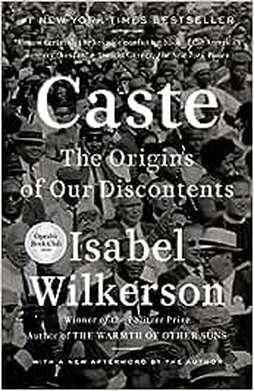 Thus is one serious downer of a book. There are examples of naked racism in BC, but they are very few. But go south and east into the US., and it is still on full display. About a year ago, I saw a reporter ask a question of a local. His answer was to refer to the "Martin Luther Coon Way", a local street . He paused after uttering the reference and said he probably should not have said it on TV. But other than that, it was what he considered normal speech. Caste is baked in in the southern US, but it is rarely referred to as such. It was thought of as a way to keep the inferior black man "in his place". Most people would refer to it as an issue of race, but rather it is an issue of tacit caste. When one thinks of caste, India leaps to mind. Their caste system is complex and alive and well. The US was the first to carve out an entire group of people from the human race. Here is a typical headline from the day: "Two men and two women and three Negroes were killed in a car accident…".To solidify the castes, teachers and the like would never refer to a black person as "Mister", "Mrs.", or "Miss". They would be referred to by their first names or by catch-alls like "boy", "girl", or "auntie". One black man got so annoyed by all this bullshit that he decided, if he were to ever have a daughter, to name her "Miss"… which he did. One day, she (Miss) was called to the school principles office. The principle asked her name. "Miss Hale" she replied. He repeated the question several times in different ways and got the same answer. He looked up her records, and found himself hoist on his own petard. He could not refer to her by name without embarrassing himself. He asked where she was from. She named a neighboring state. "That explains it… colored folks around here would not behave like this". Race is a social construct. When immigrants came to Ellis Island, they were asked "Are you black or white.". They did not understand the nonsensical question, but the their lives and the lives of their children would be deeply affected but the answer. Another famous state that indulged in caste and racism was Nazi Germany. They were only in power for about 15 years, and they had some pretty harsh views with regard to Jews, Gypsies, and many other groups. They were forced to create racial purity laws, which included rules on miscegenation. The Germans were rookies at this, so they turned to the US where similar laws had been in place for centuries. Fun fact: the babble (aka bible) justifies slavery because Ham, Noah's son, saw him naked. Makes sense, right? The US did not ditch its last endogamy laws (laws restricting interbreeding) until the year 2,000. Thanks Alabama! One minister (Lichlitter of Pennsylvania in 1910) argued before a congressional immigration panel that "oriental scum" was diluting American blood. Governor Vardaman said negroes were designed by god for menial tasks. Thanks, god! A 16 year old girl pondered what might be an appropriate punishment for Hitler after the war. Her solution: put him in black skin and let him live the rest of his life in America. Castes are supported by caste members. One thing every white man knew was that no matter how bad he was, he was better than the best black man. Each person had a caste below them that must be held in place. This kind of logic cemented the various castes in India and the US. In India, the Dalits (untouchables) are on the bottom of the heap. They do not like it there and created a group called the Dalit Panthers (patterned after the US's Black Panthers) to fight back. In the southern US, it was easier for a white felon to get a job than for an honest black man. The best predictor of whether the death penalty should be applied was not the color of the skin of the perpetrator, but the color of the skin of the victim. You would be 11 times more likely to be executed if your victim was white. In the US, it is best to avoid saying you are Danish, or Irish, Polish or any other group, especially when it comes to race and caste. Best to say you are Nordic. This seems to be the carte blanche (no pun intended) of castes. So far, no one has implied that "Nordics" were anything other than the perfect people. The US continues to lead in racism. States are purging your voter registration if you miss one year; voter ID cards are being required and, at the same time, barriers are being put up to get one. Voting stations for the people that Republicans do not like, like students and black people, are moved without notice, possibly reappearing in a farmer's field. Robert E. Lee said "The blacks are immeasurably better off here than in Africa, morally, socially, and physically." Sound familiar? Similar ideas are still popular with politicians today. After WWII, Germany paid restitution to survivors of the holocaust. After the Civil War in the US, The US paid restitution to the slave owners.. How messed up is that? Einstein was sickened by the treatment of the Jew (and blacks) in America, infinitely better though it was than the fate of European Jews. This book is hard to read. It made me sad to be a member of my species. Race is a social construct without scientific meaning. Caste is best term. The worst example of caste is the US, with India a close second. The US civil war ended more than 150 years ago, but the caste system is still alive and well today. 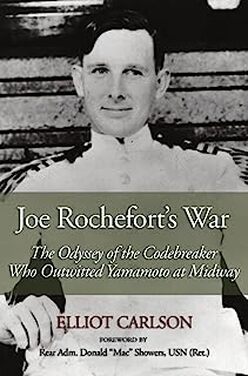 Joe Rochefort won WWII. OK, that is a bit of hyperbole, but if any one man deserves that tag line, he is it. He actually fought two wars: one against the Japanese and one against the Navy. He won both, but beating the Navy would have to wait until after his death. He lead the Hypo (a code word) sigint (signals intelligence) group from a basement in Honolulu. His team cracked the code just enough to allow Rochefort to predict with uncanny accuracy the time and place of the attack on Midway. The Japanese lost four fleet (meaning big) carriers (Kaga, Hiryu, Soryu, and Akagi) to the American's one (Yorktown). If the Americans had lost that battle, resources otherwise marked for Europe would have been routed to the Pacific. The war might have been extended by many months. One could even imagine the US dropping the A-Bomb on its originally planned target, Berlin. Joe Rochefort was a Navy man through and through. He wanted, more than anything, a sea command. He never really got one. Instead, as mentioned, he was assigned to sigint. He has spend some years in Japan learning the language and that, combined with his decoding experience and quick mind made him a good fit. There have been big two movies about Midway. The early one staring Charleton Heston is tolerable, but the latest one is much better historically. If you have seen the latter, you already know a good bit of the story. The new group started off badly. Sigint was not up to speed and they missed the attack on Pearl Harbor entirely, and so did everyone else, but the error would haunt Rochefort. Midway was sigint's revenge. The group was struggling with JN25(c), the Japanese code system. They were able to break the code and win the day, but not without drama. Joe had one albatross which he could not shake… he was a "maverick". A maverick was an officer who has had come up through the ranks but was not a graduate of Annapolis. Many, if not most, Navy officers were snobs and bigots in that respect. Three officers stand out in this regard. Wegner and the Redmans Sr. and Jr.. They wrote derogatory reports about Rochefort through Navy back-channels. Nimitz would discover this late in the game and he was furious. Early on , before much of the Japanese message traffic could be decoded, what little data they had came from Traffic Analysis (TA) of ship movements. This did not yield much and Pearl Harbor was the result. It was interesting to read about the "IBM machines" that proved to be very helpful. The machines were essentially programmable punch card sorters. Sorting was one of the early targets of computing. When the hammer fell on Honolulu, the Americans could intercept radio traffic but they could not tell what direction it was coming from. They could only say that the source was either at one bearing, or that bearing +180 degrees. In other words, their equipment was primitive even for the time, and it lacked direction finding capabilities. Six aircraft carriers attacked Pearly Harbor. Luckily, the US aircraft carriers were at sea. Equally lucky was that the Japanese did not hit Pearl's huge stockpile of oil. After Pearl, the Navy went on a witch hunt and largely blamed Admiral Kimmel. He would face years of criticism before taking his own life. Nimitz took over the Pacific Theater. Rochefort did not escape criticism from the likes of the Redmans. The good news for Rochefort was the increasing presence of sigint in war. The next major battle of the Pacific war was Coral Sea. The battle was a draw, but the Japanese were, for the first time, halted. The next engagement would be Midway where the Japanese would face defeat for the first time. Rochefort and his team had identified Midway as the next target. The JIN's (Japanese Imperial Navy) code for Midway was AF. Washington (the Redmans again) disagreed. Famously, the US suckered the Japanese into tipping their hand on AF. They sent a message "in the clear" that Midway's fresh water condenser was broken. The Japanese noted that AFs water condenser was down. This was Rochefort's second error… he made Washington look stupid. But he was right. The Americans used Rochefort's uncanny predictions to sink all four of the Midway bound carriers. Nimitz famously remarked that Rochefort was only off by five minutes, five miles and five degrees. The rat bastard Redmans later tried to argue that the only reason Rochefort succeeded was because of work that they had previously done. That was BS but they kept at it. When Rochefort was put up for the Distinguished Service Medal (DSM), they nixed it, arguing in part that he did nothing himself, only his people did! By that logic, no officer would ever receive a medal. Rochefort was also able to provide key information relating to the next major contest: Guadalcanal. Rochefort would die before he was finally awarded the DSM (the highest military honor the US gives) by Ronald Reagan. This book was a long read, but I never lost interest. It is the story of a naval battle that would rank up there with Jutland and Trafalgar. 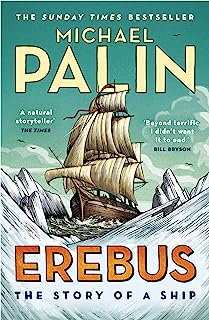 I was surprised when my friend Dave Harper, quite accidently and coincidentally, suggested I read this book. I had just completed my model of the Erebus' sister ship HMS Terror, a fact that Dave did not know. It also surprised me that the book was written by Monty Python alum Michael Palin. Palin is well known as a globe trotter and as it turns out, he is very much interested in the days of English exploration. The Terror and the Erebus were "bombs". A bomb ship was a warship that used mortars rather than cannon. Mortars demand a strong and sturdy platform to fire from, which in turn demands a reinforced deck and substructure. They served in war, but when the wars ended, their design features made them good at arctic exploration. In other words they were, with some additional modifications, good ice-breakers. The Terror was about 10 years older than the Erebus. Erebus was a Greek god similar to Satan. They were primarily sailing ships, but both had a small (25 hp) steam engine and a propeller that could move them at about 4 knots. I could find no instance in the book where they were ever used. Modern icebreaker engines deliver 40,000 hp. The Erebus and Terror teamed up, with the newer Erebus in charge, to find both the North and South Magnetic Poles. They succeeded in the former quest and failed in the latter. They were at sea for 4 years, and narrowly avoided being caught in the ice at both ends of the Earth. They went further south than any previous voyage. Many years later, Shackleton would break their record. In May 1845, the Franklin Expedition set out, with the same two bombs, to try and navigate the Northwest Passage. John Franklin and his two crews would never see England again. The story of the Franklin Expedition is mostly speculation. A lot of money and rewards were spent to find them. They actually survived on the ice for about three miserable years. The wrecks of the Erebus and the Terror were found in 2014 and 2016. Some bodies were found and analyzed. They all had elevated lead levels. What role lead had in the loss is hard to say. These men were tough as nails. It is not surprising that several of them tried to jump ship. This is a fairly long book. It you are interested in the days of sail, or the politics of exploration and scientific discovery, it is an interesting read. The image below is my model of the Terror. The Erebus would have looked very similar. 199 Days The Battle for Stalingrad; Edwin P. Hoyt; 1993; Forge Books; 287 pgs; index, bibliography2/7/2023 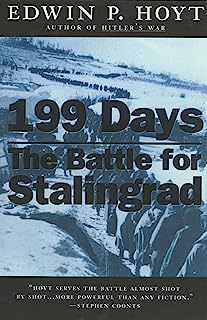 I have read several books about Stalingrad. This is definitely one of them. The Battle of Stalingrad was contingent on the Russians winning Battle of Moscow. It was a close thing. Had the Germans been better prepared for cold weather conditions, they could have taken Moscow. The battle for Stalingrad began in July 1942 and ended in February 1943. Stalingrad was surrounded to the west and supplied from the other side of the Volga to the east. The fighting was bitter. Hitler wanted the Caucasus mountains for oil and Stalingrad for its name… mostly. As the Battle of Stalingrad progressed, the German army found itself hungry for the 650 tonnes of supplies per day it needed to fight. They were supplied by a single railroad line that became a pivotal target for the Russians. By October, the Russians had control of the air. In November, 250,000 Germans were trapped in a pocket around downtown Stalingrad. The Germans called it the Kessel (Caldron in English). This was the turning point of the entire war. The Russians decided to starve the Kessel. The German Luftwaffe tried to supply the Kessel from the air. The Russians shot down many supply sorties. The Germans starved to the tune of one dying every 7 seconds. The Germans were butchering 300 horses a day. Hitler was a much better tactician than Stalin, but both managed to make some very big errors. The difference was that Stalin could afford them. Von Paulus, the German head of the sixth army trapped in the Kessel, surrendered in February 1943. He had just been promoted to Field Marshal. Hitler thought the new rank would force him and his men to fight to the death. Miss Leavitt's Stars; George Johnson; 2005; Atlas Books; 162 pgs, Acknowledgements, notes, index,28/5/2023 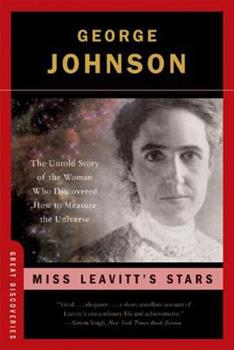 I have often thought about how much further mankind might be if we (men) had not banished half of the worlds brightest minds (women) to a life of drudgery and gestation. But every now and then, one or two women manage to beat the odds. Henrietta Swan Leavitt was one. Miss Leavitt was an astronomer, although her official title was "computer". She was a diligent researcher who spent much of her time measuring the apparent brightness of stars recorded on photographic plates. In her day (circa 1915), the words "galaxy" and "universe' were synonyms. Examining the brightness of star can give clues to how far away it is. If you know how far away it is, you can know its absolute brightness and vice versa. Ms Leavitt studied stars in the Magellanic Clouds. Some stars are called "variable" stars, Their brightness varies over time. Some of those stars are Cepheid variables. What Miss Levitt discovered was that all Cepheid variables that share the same period also have the same absolute brightness. In other words, Cepheids can be used as a "standard candle". Once the distance to one Cepheid star is known, it is trivial to calculate how far away other Cepheids are. The story of determining the size of the universe is some what more complex. For example, inter stellar dust mucks up the calculations. But Henrietta's discovery was the first step. Before her discovery, Andromeda was though to be a cloud inside the Milky Way, which in turn was thought to be about 100,000 light-years across. Her work showed that Andromeda was another galaxy even larger than the Milky Way, and was something like two million light years away. Another well known modern standard candle today is the type 1A supernova. This book is a quick read, and an interesting recounting the squabbles between stubborn astronomers as the moved slowly towards a much grander description of the universe in which we live. Miss Leavitt was born in 1868 and died of cancer in 1921. 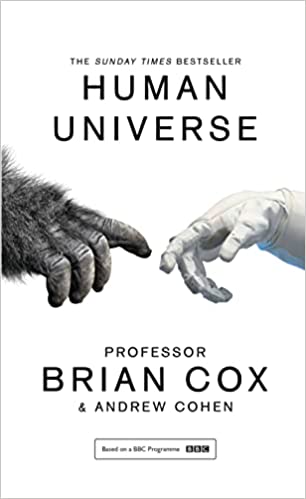 Brian Cox is a few years younger than I. He looks to be much younger. This book is a companion to his TV series. For me, it was largely bubble gum. I am familiar with the history of science, the current state of paleontology, and scientific philosophy, so only a small fraction of the book's thoughts and facts were unknown to me. His writing style is fine… anyone who discusses the Spanish Inquisition and adds that "nobody expects them" is OK by me. Having said that, it would be a good read for the average person who wishes to hear possible scientific answers to most of the BIG profound questions. On that basis, I would say it is a fine read. |
AuthorLee Moller is a life-long skeptic and atheist and the author of The God Con. Archives
May 2024
Categories
All
|
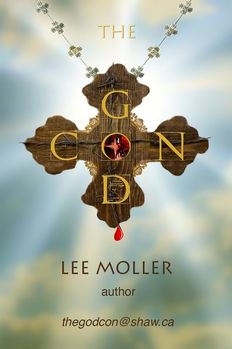


 RSS Feed
RSS Feed